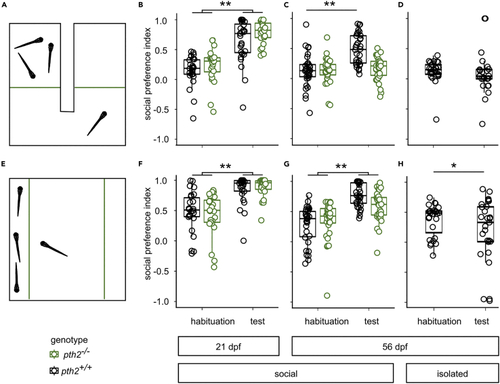Fig. 3
- ID
- ZDB-FIG-230315-106
- Publication
- Anneser et al., 2022 - The neuropeptide Pth2 modulates social behavior and anxiety in zebrafish
- Other Figures
- All Figure Page
- Back to All Figure Page
|
Maintenance of social preference is disrupted in pth2−/− mutants (A) Scheme of the U-shaped chamber, in which the experimental fish could spend time in either of two adjacent compartments, separated by acrylic glass (green line) (Dreosti et al., 2015). Visual access to three age-matched wild-type conspecifics was only possible in one of the two areas. (B) Boxplots indicate the preference for the social area displayed by pth2+/+ (n = 28) and pth2−/− fish (n = 24) at 21 dpf during habituation and in response to the presence of stimulus fish. While animals showed no preference during the habituation period, they spent a significantly increased amount of time close to conspecifics during the test period (two-way ANOVA, pF=93.02 = 5.94e-16). (C) At 56 dpf, both the presence of conspecifics (two-way ANOVA, pF=20.4 = 0.000015) and the genotype of the animals (two-way ANOVA, pF=13.94 = 0.0003; n = 32 for wildtype and 31 for mutants) contributed significantly to social preference. Additionally, we found a significant interaction between these factors (pF=13.89 = 0.0003). A post-hoc Tukey-Kramer test indicated that pth2+/+ fish displayed a significant increase in SPI under test conditions (pq=8.25 = 0.001), whereas pth2−/− fish did not (pq=0.72 = 0.9). (D) Boxplots show the effect of rearing animals in isolation on social preference. In 56 dpf animals, the presence of conspecifics led to no detectable change in behavior (n = 25; paired, two-sided t-test: pt=0.78, df =23 = 0.44, effect size = 0.13, mean social preference during habituation: 0.12, during test conditions: 0.08). (E) Scheme for open field social preference test, in which fish could move freely in a rectangular dish, while having visual access to three conspecifics. (F) Boxplots indicate social preference of wild-type (n = 26) and pth2−/− fish (n = 25) at 21 dpf during the habituation period and in response to stimulus fish. The presence of conspecifics during the test period altered behavior of all animals significantly (two-way ANOVA, pF=53.41 = 7.35e-11), while genotype did not influence behavior (two-way ANOVA, pF=0.46 = 0.49). (G) At 56 dpf, the presence of conspecifics (pF=56.23 = 1.14e-11) and its interaction with the test animal’s genotype (pF=7.25 = 0.008) significantly altered social preference (for pth2−/−, n = 32, for pth2+/+, n = 31). A post-hoc Tukey-Kramer test indicated a significant preference for the arm with conspecifics (when compared to the habituation period) in pth2+/+ fish (pq=10.15 = 0.001, effect size: 1.93). In pth2−/− fish, the same effect was present, although less pronounced (pq=4.88 = 0.004, effect size: 0.82). (H) After 8 weeks of social isolation, pth2+/+ fish displayed no social preference toward conspecifics and rather exhibited an avoidance reaction (two-sided, paired t-test: pt=2.06 = 0.049, n = 27) |
| Fish: | |
|---|---|
| Observed In: | |
| Stage Range: | Days 21-29 to Days 45-89 |

